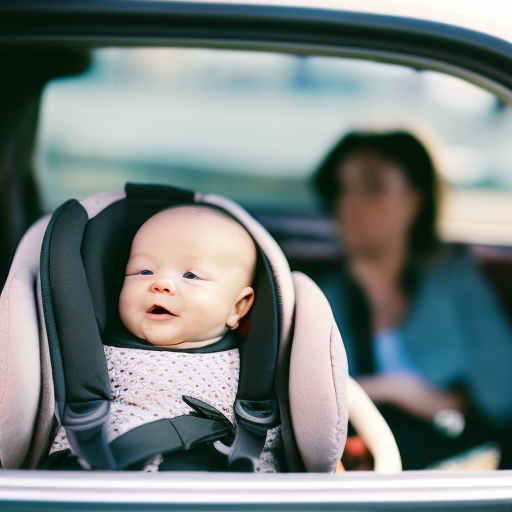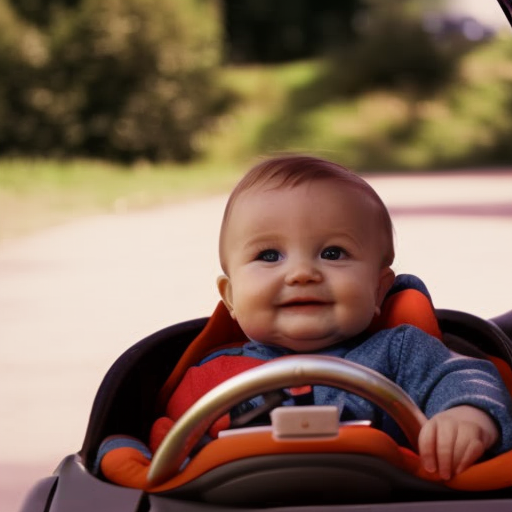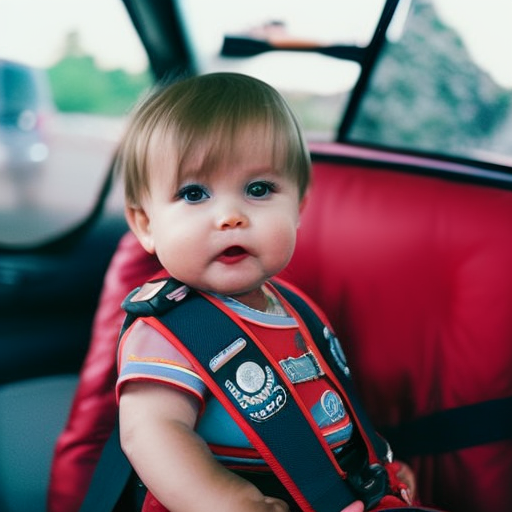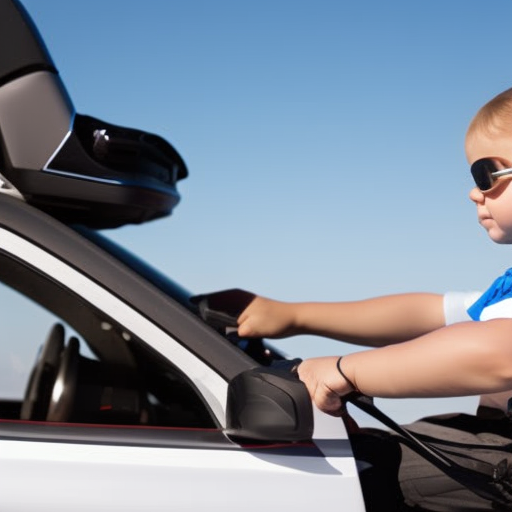"Cherishing Little Steps - A Haven for Baby and Family Journeys"
Guide to Car Seat Stages
Are you ready to embark on a journey that symbolizes safety and protection for your little one? Welcome to your Guide to Car Seat Stages!
As a parent, your top priority is ensuring your child’s well-being, especially when it comes to traveling in a car. This intimate guide will walk you through the different stages of car seats, from rear-facing infant seats to forward-facing toddler seats and beyond.
You’ll discover the benefits of convertible car seats, all-in-one car seats, combination car seats, and five-point harness seats. We’ll also delve into the LATCH system and installation, as well as provide you with essential car seat safety guidelines.
So, let’s dive in and find the perfect car seat for your precious cargo!
Key Takeaways
- Rear-facing seats provide the highest protection in car accidents and experts recommend keeping children in rear-facing seats for as long as possible.
- Convertible and all-in-one car seats can be used in both rear-facing and forward-facing positions, providing flexibility as the child grows.
- Forward-facing toddler seats and combination car seats offer additional protection and can transition from rear-facing to forward-facing.
- Booster seats elevate the child to the correct height for the seat belt to fit properly and provide a gradual transition from a car seat to a regular seat belt.
Rear-Facing Infant Seats

To ensure optimal safety for your child, rear-facing infant seats provide the highest protection in the event of a car accident. When it comes to choosing between rear-facing and forward-facing seats, experts recommend keeping your child in a rear-facing position for as long as possible. This is because rear-facing seats offer better support for your child’s head, neck, and spine, reducing the risk of injury in a crash.
When installing a rear-facing infant seat, it’s crucial to follow the manufacturer’s instructions carefully. Start by positioning the seat in the back seat of your vehicle, preferably in the middle seat. Make sure the seat is level and tightly secured using either the vehicle’s seat belt or the LATCH system. The LATCH system, which stands for Lower Anchors and Tethers for Children, provides an easy and secure way to attach the seat to your car’s anchors.
Additionally, it’s essential to ensure that the harness straps are properly adjusted. The shoulder straps should be at or below your child’s shoulders, and the chest clip should be positioned at armpit level. Remember to remove any bulky clothing or blankets before buckling your child into the seat to ensure a snug fit.
Convertible Car Seats

When transitioning from rear-facing infant seats, you’ll need to consider the benefits of using convertible car seats. Convertible car seats are designed to be used in both rear-facing and forward-facing positions, offering flexibility as your child grows.
Installation of a convertible car seat is crucial for ensuring your child’s safety. Make sure to carefully follow the manufacturer’s instructions and use the appropriate installation method, whether it’s using the vehicle’s seat belt or the LATCH system. It’s important to periodically check the installation to ensure that the seat is securely in place.
When it comes to convertible car seat safety, there are a few key things to keep in mind. First, always make sure that the harness straps are properly adjusted and snug against your child’s body. The harness should be at or below your child’s shoulders when rear-facing, and at or above the shoulders when forward-facing. Additionally, the chest clip should be positioned at armpit level.
Regularly check the car seat for any signs of wear or damage, and replace it if necessary. Finally, remember to never leave your child unattended in the car seat, even for a short period of time.
All-in-One Car Seats
If you’re considering transitioning from a convertible car seat, an all-in-one car seat is an excellent option to meet your child’s changing needs. All-in-one car seats are designed to grow with your child, accommodating different stages of development from infancy to toddlerhood and even beyond.
One of the key benefits of an all-in-one car seat is its versatility. It can be used as a rear-facing infant seat, a forward-facing toddler seat, and eventually, as a booster seat. This means that you only need to make one purchase to cover all your car seat needs, saving you time and money.
When choosing the right all-in-one car seat, there are a few factors to consider. First, check the weight and height limits to ensure that the seat can accommodate your child’s size and age. Look for features such as adjustable harnesses, reclining options, and easy installation systems. Additionally, consider the overall safety ratings and reviews from other parents. It’s also a good idea to check if the car seat meets the necessary safety standards set by organizations like the National Highway Traffic Safety Administration (NHTSA).
Forward-Facing Toddler Seats
Now let’s talk about why you should consider a forward-facing toddler seat as the next stage in your child’s car seat journey.
-
Safety: Forward-facing toddler seats provide additional protection for your growing child. The five-point harness and sturdy design help to minimize the risk of injury in the event of a collision.
-
Comfort: These seats are designed with your child’s comfort in mind. They often come with padded cushions and adjustable headrests to ensure a cozy and secure fit.
-
Installation tips: When installing a forward-facing toddler seat, make sure to follow the manufacturer’s instructions carefully. Ensure that the seat is securely attached to the car’s seat using either the LATCH system or the seat belt. Double-check that the seat is at the correct recline angle for your child’s age and weight.
-
Cleaning and maintenance: Keeping your child’s car seat clean is essential for their health and safety. Regularly remove the cover and wash it according to the manufacturer’s instructions. Use mild detergent and avoid harsh chemicals that could damage the fabric. Remember to wipe down the seat and harness regularly to remove any spills or dirt.
-
Transitioning to a booster seat: Eventually, your child will outgrow their forward-facing toddler seat. When they reach the weight and height limits specified by the manufacturer, it’s time to transition them to a booster seat. This will provide them with the necessary support and protection until they’re ready to use the vehicle’s seat belt alone.
Investing in a forward-facing toddler seat is a crucial step in ensuring your child’s safety and comfort during car rides. Follow installation tips and maintain the seat properly for long-lasting use.
Combination Car Seats
To transition your child to the next stage of car seats, consider using a combination car seat. Combination car seats are designed to accommodate children as they grow and provide several benefits.
One of the main advantages is that they can be used in both rear-facing and forward-facing positions, allowing for a smooth transition from an infant seat. This means that you can use a combination car seat for a longer period of time, saving you money in the long run.
Another benefit of combination car seats is that they come with a built-in harness system that can be adjusted as your child grows. This ensures a secure fit and provides optimal protection in the event of a crash.
When it comes to transitioning from an infant seat to a combination car seat, it’s recommended to make the switch once your child reaches the maximum weight or height limit of their current seat. This can vary depending on the specific model, so it’s important to consult the manufacturer’s guidelines for your particular car seat.
Booster Seats
Continue the discussion from the previous subtopic of combination car seats by exploring the benefits of using booster seats for your child’s next stage of car seat. Booster seats are an important transition between car seats and regular seat belts, ensuring your child’s safety as they grow. Here are some key reasons why booster seats are a crucial step in your child’s car seat journey:
-
Belt Positioning Booster: Booster seats are designed to elevate your child to the correct height, allowing the seat belt to fit properly across their body. This ensures that the seat belt is positioned correctly, reducing the risk of injury in the event of a crash.
-
Weight and Height Limits: Booster seats have weight and height limits that are important to follow. It’s crucial to choose a booster seat that fits your child’s measurements to provide optimal safety and protection.
-
Comfort and Convenience: Booster seats are designed to be comfortable, with padded seats and armrests. They also offer convenience as they can easily be transferred between vehicles.
-
Increased Visibility: Booster seats elevate your child, allowing them to see out of the car window. This not only enhances their overall experience but also allows them to observe their surroundings, promoting their cognitive development.
-
Gradual Transition: Booster seats provide a gradual transition from a car seat to a regular seat belt, ensuring that your child becomes accustomed to using seat belts correctly before fully relying on them.
High-Back Booster Seats
When choosing a high-back booster seat for your child, it’s important to consider the added safety benefits it provides. High-back booster seats have become popular due to their ability to provide extra protection and support for your child. These seats feature a tall backrest that provides head and neck support, reducing the risk of whiplash in case of a collision. The high back also helps position the seat belt correctly across your child’s chest and shoulder, minimizing the risk of injury in an accident.
One of the key benefits of high-back booster seats is their ability to provide side-impact protection. The tall backrest and adjustable headrests help shield your child from side collisions, reducing the risk of injury to their head and neck. Additionally, high-back booster seats often come with reinforced side wings that provide extra protection in case of a side impact.
Another advantage of high-back booster seats is their versatility. Many models come with adjustable features, allowing you to customize the seat to match your child’s height and weight. This adaptability ensures that your child is always properly positioned and secure in their seat.
Backless Booster Seats
Choose a comfortable and secure backless booster seat for your child’s safety. Backless booster seats are designed to elevate your child to the correct height for the seat belt to fit properly. Here are some important things to consider when selecting a backless booster seat:
-
Safety features: Look for seats with side-impact protection and a sturdy frame to provide optimal protection in the event of a crash. Additionally, choose a seat with a belt-positioning clip to ensure the seat belt rests correctly on your child’s shoulder and lap.
-
Age and weight requirements: It’s essential to choose a backless booster seat that’s appropriate for your child’s age and weight. Most seats have a minimum weight requirement of around 40 pounds and are suitable for children between the ages of 4 and 8.
-
Comfort: Your child will be spending a significant amount of time in the booster seat, so comfort is crucial. Look for seats with ample padding and adjustable armrests to provide a cozy and supportive ride.
-
Ease of use: Select a backless booster seat that’s easy to install and adjust. Look for seats with clear instructions and simple installation features, such as a latch system or seat belt guides.
-
Durability and quality: It’s important to choose a backless booster seat that’s made from high-quality materials and has a durable construction. Check for safety certifications and read reviews from other parents to ensure you’re selecting a reliable product.
Five-Point Harness Seats

To ensure maximum safety for your child, consider using a versatile five-point harness seat in your car. Five-point harness seats offer numerous benefits that make them an ideal choice for keeping your child secure while on the road.
One of the main benefits of five-point harness seats is the enhanced protection they provide. With five attachment points (shoulders, hips, and crotch), they distribute crash forces over a larger area, reducing the risk of injury. Additionally, the adjustable straps allow for a snug fit, minimizing the potential for your child to move around during a collision.
Proper installation and usage of five-point harness seats are crucial for their effectiveness. Here are some guidelines to follow:
- Always refer to the manufacturer’s instructions for installation.
- Ensure the seat is securely and tightly fastened to the car’s seat.
- Adjust the harness straps to fit snugly against your child’s body, with the shoulder straps at or below their shoulders.
- Regularly check and adjust the harness as your child grows.
By using a five-point harness seat correctly, you can provide your child with the highest level of protection during car rides.
LATCH System and Installation

To ensure secure and convenient installation of your car seat, regularly utilize the LATCH system and follow these guidelines:
-
LATCH system benefits: The LATCH system, which stands for Lower Anchors and Tethers for Children, provides a safer and more secure way to install your car seat compared to using the vehicle’s seat belt. The LATCH system consists of anchor points in the vehicle and connectors on the car seat that easily attach to each other, eliminating the need for seat belt routing.
-
Proper car seat installation: When installing your car seat using the LATCH system, make sure to follow the manufacturer’s instructions carefully. Ensure that the connectors are properly attached to the anchor points and that there’s no excessive slack in the straps. Double-check the tightness of the installation by trying to move the car seat side to side and forward and backward. It shouldn’t move more than an inch in any direction.
-
Weight limits: Be aware of the weight limits specified by the car seat manufacturer for using the LATCH system. Once your child reaches the weight limit, you’ll need to switch to using the vehicle’s seat belt for installation.
-
Inspect regularly: Regularly inspect the LATCH system and connectors for any signs of wear or damage. If you notice any issues, contact the car seat manufacturer for further guidance.
-
Installation assistance: If you’re unsure about how to properly install your car seat using the LATCH system, seek assistance from a certified Child Passenger Safety Technician. They can provide guidance and ensure that your car seat is installed correctly.
Car Seat Safety Guidelines

When ensuring the safety of your child in a car seat, it’s important to follow these car seat safety guidelines.
To begin, let’s talk about car seat installation tips. First and foremost, always read the car seat manual and the vehicle owner’s manual thoroughly before installing the car seat. This will ensure that you have a clear understanding of the correct installation process. Additionally, make sure to use either the LATCH system or the vehicle seat belt to secure the car seat. Whichever method you choose, ensure that the seat is tightly installed with minimal movement.
Next, let’s discuss the car seat inspection checklist. Before every car ride, take a moment to inspect the car seat for any signs of damage or wear. Check for cracks, frayed straps, and loose parts. It’s also crucial to ensure that the harness straps are properly adjusted and snug on your child. The chest clip should be at armpit level to prevent the straps from sliding off. Finally, make sure the car seat is facing the correct direction based on your child’s age and weight.
Following these car seat safety guidelines will help ensure that your child is protected in the car. Remember, your child’s safety is of utmost importance, so take the time to properly install and inspect the car seat before every journey.
Choosing the Right Car Seat
Now, let’s delve into how to choose the right car seat for your child. When it comes to ensuring your child’s safety on the road, selecting the appropriate car seat is crucial. To help you make an informed decision, consider the following tips:
-
Check the weight limits: Each car seat has specific weight limits that determine its suitability for your child. Make sure to choose a seat that accommodates your child’s weight and age.
-
Consider your child’s age: Car seats are designed to cater to different stages of your child’s growth. From rear-facing infant seats to forward-facing toddler seats and booster seats, choose the one that aligns with your child’s age and developmental needs.
-
Research the installation methods: Proper installation is key to maximizing the effectiveness of a car seat. Look for seats that offer easy installation methods and consider seeking professional help if needed.
-
Evaluate the safety features: Look for car seats with additional safety features such as side-impact protection, energy-absorbing foam, and adjustable harnesses to provide optimal protection for your child.
-
Read reviews and seek recommendations: Researching customer reviews and seeking recommendations from trusted sources can provide valuable insights and help you make an informed decision.
Frequently Asked Questions
How Do I Properly Clean and Maintain My Car Seat?
To properly clean and maintain your car seat, follow these steps: 1) Use proper cleaning techniques, such as vacuuming, spot cleaning, and using mild soap and water. 2) Regularly check for any wear and tear, and fix or replace as needed.
Can I Use a Car Seat That Has Been Involved in a Minor Accident?
Yes, you can use a car seat that has been involved in a minor accident, but it’s crucial to clean it thoroughly and check for any damage. Remember to also consider the car seat’s expiration date.
Are There Any Specific Car Seat Requirements for Children With Special Needs?
If your child has special needs, it’s important to consider specific car seat requirements. Look for car seat accessories that cater to their needs, and follow car seat safety tips to ensure their safety on the road.
Can I Use a Car Seat That Is Expired?
Using an expired car seat can pose safety concerns and have legal implications. It’s important to check the expiration date and follow manufacturer guidelines. Your child’s safety should always be a top priority.
What Should I Do if My Child Outgrows Their Car Seat Before They Are Ready to Transition to the Next Stage?
If your child outgrows their car seat before they’re ready to move to the next stage, don’t panic! There are alternative options like extended rear-facing seats that provide safety and comfort.
Conclusion
So there you have it, folks! You’ve now been armed with the ultimate guide to navigating the world of car seat stages.
From rear-facing infant seats to combination car seats, we’ve covered it all.
Remember, choosing the right car seat is crucial for your child’s safety, so follow the LATCH system and installation guidelines to ensure a secure fit.
Stay informed, stay safe, and happy travels!


